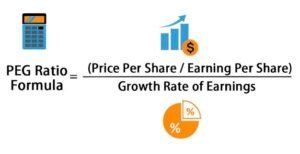Valuing stocks is a very important skill for investors to make right trading decisions in the financial markets. The aim of stock valuation is to determine whether shares of a company are fairly priced, overpriced or underpriced.
One important strategy to this process includes utilizing valuation ratios, which offer quick insights into relative value of a stock. These ratios compare different aspects of a company’s working to its stock price.
By understanding and using these ratios, investors get valuable views on potential investments and make more confident choices in their portfolio management techniques.
Key Valuation Ratios

Valuation ratios are very important tools to calculate the relative value of stocks. These metrics provide a fast and efficient way to compare firms within an industry or across sectors. Using them, investors can get valuable insights into a company’s growth outlook, market view and financial health.
Price-to-Earnings (P/E) Ratio
The Price-to-Earnings (P/E) ratio compares a stock price to earnings per share (EPS). It divides the current share price by EPS.
There are two main types – historical P/E ratios that use past earnings and forward P/E ratios which utilizes predicted future earnings.
Understanding P/E ratios includes comparing to industry averages. A high P/E ratio may signal overvaluation or high expected growth, while a low P/E ratio shows undervaluation or risks. However, P/E ratios have limitations like not accounting for debt or less useful without earnings.
Example: If a $50 stock has $5 EPS, its P/E is 10.
Price-to-Book (P/B) Ratio

Price-to-Book (P/B) ratio differentiates market value from book value – a company’s assets minus liabilities. It divides stock price by book value per share that’s connected to shareholders’ equity.
A high P/B ratio may show investors expect the firm to form value above its asset level. A low P/B ratio may show financial issues or undervaluation. This ratio is very useful to analyze asset heavy companies or financial institutions..
However, P/B ratio has limitations such as incorporating intangibles or less relevant for service companies with few physical assets.
Example: A company with $100M assets, $75M liabilities has $25M book value. With 10M shares at $5, its P/B is 2.0.
Price-to-Sales (P/S) Ratio

The Price-to-Sales ratio contrasts a firm’s market value to its revenue. It’s calculated by dividing the share price by sales per share. This metric is specially useful as sales values tend to be more stable than profits. These make the P/S ratio a reliable stock valuation tool.
A low P/S ratio can represent an undervalued equity, while a high P/S ratio may show overvaluation or strong growth hopes. This ratio is particularly helpful to assess the companies which have changing or no earnings like cyclical businesses or startups.
Example: If Company A has a $2 billion market cap and $1.5 billion in sales, its P/S ratio is 1.3x. If Company B has the same market cap but $1.3 billion in sales, its P/S ratio is 1.5x.
Price/Earnings to Growth (PEG) Ratio

The Price/Earnings to Growth ratio extends the P/E ratio by including expected earnings growth rate of companies. It is calculated by dividing the P/E ratio by the projected earnings growth percentage. This gives a complete view of the stock’s valuation by understanding future predicted growth and current earnings.
Generally, a PEG ratio under 1 suggests possible undervaluation given growth prospects. On the other hand, a PEG ratio above 1 may indicate overvaluation. However, this tool has drawbacks such as depending on growth shows that could miss targets.
Example: If a firm has a 20 P/E ratio and 10% expected earnings growth, its PEG ratio is 2.0 (20 / 10).
Enterprise Value to EBITDA (EV/EBITDA) Ratio
The Enterprise Value to EBITDA (EV/EBITDA) ratio is a complete valuation tool that evaluates cash position and debt of a company. It’s calculated by dividing the enterprise value by earnings before interest, taxes, depreciation and amortization (EBITDA).
A low ratio of EV/EBITDA shows undervaluation. On the other hand, a high ratio represents high growth or overvaluation. This ratio helps to compare companies with tax rates or different capital structures.
For example, A company with an enterprise value of $500 million and an EBITDA of $50 million has an EBITDA ratio of 10.0.
Price to Cash Flow (P/CF) Ratio
The Price to Cash Flow (P/CF) ratio is a tool of valuation that’s used to assess a company’s stock price to its cash flow per share. It’s calculated by dividing the stock price by cash flow per share. This ratio is very important because cash flow is generally taken as a more reliable factor of financial health than earnings which can be easily changed.
A low P/CF ratio indicates undervaluation. On the other side, a high ratio shows overvaluation. This ratio helps in assessing companies with significant non cash expenses or capital intensive sectors.
Example: A company with a stock price of $50 and cash flow per share of $5 has a P/CF ratio of 10.0.
Applications of Valuation Ratios
Valuation ratios are powerful tools helping investors make right choices. Let’s see how to apply these in real investing cases. The applications of valuation ratios are given below:
Comparative Analysis

Comparing valuation ratios between industry peers is important for investors. This technique helps find potentially under or overvalued stocks versus competitors. For instance, if most tech firms have a P/E ratio of ~20 but one is at 10, it may be worth looking into.
Here’s how to perform it:
- Choose a ratio such as P/S or P/E for analysis.
- Identify the ratios for many companies in the industry.
- Calculate average ratio for the sector.
- Compare each company’s ratio to the average.
- Identify stocks that seem undervalued or overvalued.
This method can indicate good investment opportunities and help avoid overpriced shares.
Historical Comparisons
Seeing how a stock’s valuation ratios changed over time shows important trends. This helps investors know if a stock trades at a higher or lower value than historically.
Consider to:
- Get data on stock’s valuation ratios over many years.
- Look for patterns for these ratios.
- Compare current ratio to historical average.
- Study what may cause significant changes.
For example, a rising P/B ratio may signal growing confidence or improving performance. Declining may indicate issues. Comparing historical averages shows if a stock trades at a premium or discount to its own past.
Contextual Analysis

While valuation ratios give useful data, they shouldn’t be used alone. It’s important to consider other factors when valuing stocks using ratios too. This wider view helps investors make informed choices. Here’s what to think about:
- Check overall market state. Are stocks generally pricey or affordable now?
- Think about the company’s growth potential. Fast expanding companies might warrant higher ratios.
- Consider industry trends. Some sectors naturally have higher or lower ratios.
- Review the company’s money, health and management quality.
- Factor any special stuff affecting the company’s value.
For instance, a high P/E ratio could be fine for a quickly growing firm in a booming market. By mixing ratio analysis with this broader research, investors avoid traps and make better stock valuation calls.
Valuation Ratios Benefits

valuation ratios offer several key upsides for investors aiming to make informed stock choices. These tools are easy to use and get, making them good even for newbies. By giving a fast check of a company’s money health, valuation ratios help compare stocks easily.
- One big plus is doing cross-company and cross-industry analysis. This allows spotting potential bargains or overvalued stocks. For example, a low P/E ratio versus peers might indicate an underpriced stock.
- Historical context is another strength of valuation ratios. By seeing ratio changes over time, investors identify trends and sentiment shifts. This long view aids understanding a company’s growth path and financial stability.
- valuation ratios also enable quantitative decision-making, reducing subjective biases. They give hard numbers to support choices, making the process more objective.
- Lastly, these ratios work well for different industries and companies, from growing tech firms to stable blue chip stocks.
Limitations of Valuation Ratios

While valuation ratios help investors, they have some limits also:
- Inaccurate Data – Ratios depend on correct information. Wrong or manipulated numbers make ratios unreliable.
- Market condition can distort ratios by making stocks seem over/undervalued in bull or bear markets.
- Accounting Methods – Different revenue or expense recording can modify a financial status of a firm. This makes comparing ratios across companies or industries difficult.
- Lastly, valuation ratios don’t tell everything. They miss things such as management quality, future growth potential and brand value. Utilizing ratios needs broader analysis when valuing stocks.
Conclusion
Valuation ratios powerfully inform investors to make right decisions. They quickly show the market view and financial health of a company.
However, you should use multiple ratios for a complete picture as no single ratio tells the full story. While these tools are valuable, they’re just part of complete research. Always understand other factors such as broader economic conditions, industry trends and company management.
You now know about valuation ratios. Bring your investment plan up a level by learning the top-down and bottom-up investment methods. See how these two approaches can complement your ratio analysis for a smarter investment choice.


